
The Indian locomotive class WDM-2 is a class of diesel–electric locomotive that was developed in 1962 by American Locomotive Company (ALCO) for Indian Railways. The model name stands for broad gauge (W), Diesel (D), Mixed traffic (M) engine, 2nd generation (2). They entered service in 1962. A total of more than 2,700 WDM-2 was built at ALCO and Banaras Locomotive Works, Varanasi between 1962 and 1998, which made them the most numerous class of mainline diesel locomotive until its successor the WDM-3A.
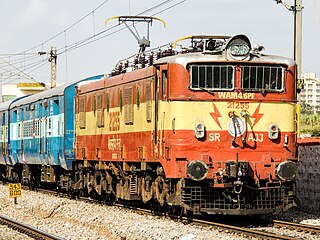
The Indian locomotive class WAM-4 is a class of 25 kV AC electric locomotives that was developed in 1970 by Chittaranjan Locomotive Works for Indian Railways. The model name stands for broad gauge (W), alternating current (A), mixed traffic (M) locomotive, 4th generation (4). They entered service in March 1971. A total of 500 WAM-4 were built at CLW between 1970 and 1983, which made them the most numerous class of mainline electric locomotive till its successor the WAG-5.

The Indian locomotive class WDG-4 is a type of six-axle (Co-Co) freight-hauling diesel–electric locomotive with AC electric transmission designed by General Motors Electro-Motive Diesel in 1997–1998 for Indian Railways, where they are classed as WDG-4. Derived from the EMD SD70MAC, it is powered by a 4,000 hp (3,000 kW) 16-cylinder EMD 710G3B prime mover. Thirteen were built by EMD as order #958647, and a further eight were exported in kit form and assembled in India. The class entered service in 1999. A Dedicated Passenger version of this locomotive, the WDP-4, has also been produced, with a Bo1-1Bo Wheel Configuration, which entered service in 2001. These locomotives are also famous for, and can be identified by, the distinct Jet Turbine Engine–like sounding property of the EMD 710 prime mover.

The Indian locomotive class WDP-4 is a passenger-hauling diesel–electric locomotive with AC electric transmission designed by General Motors Electro-Motive Division and built by both GM-EMD and under license by Banaras Locomotive Works (BLW) of Varanasi, India for Indian Railways as the classes WDP4, WDP4B and WDP4D. The GT46PAC is a passenger version of the previous Indian Railways EMD GT46MAC freight locomotive. The locomotive has a 16-cylinder 710G3B diesel engine and is one of the fastest diesel–electric locomotives in service in Indian Railways.
The ALCO DL560C is a series of diesel–electric locomotive with AC electric transmission designed by the American Locomotive Company and produced under license by Banaras Locomotive Works (BLW) Varanasi, India for Indian Railways as their classes WDM-2, WDM-3A/2C, WDM-3D and WDG-3A for operation in India. The locomotive is fitted with a 16-cylinder ALCO 251 B, C diesel engine. In the early 1960s Indian Railways needed a reliable diesel workhorse to gradually replace its steam locomotive fleet. Equal numbers of ALCO's DL560C and EMD's G16 were chosen for trials. More locomotives of each of these were purchased for more trials. Indian Railways was keen on producing these locomotives in the country rather than depending on imports. EMD did not agree for a Transfer-of-Technology, while ALCO did. Thus ALCO DL560C was chosen for the job due to its easy maintenance, reliability and simple operation. And from then on vast numbers of this loco in different configurations have been produced and remain the main diesel traction power of Indian Railways.
The Nagpur–Secunderabad line is a railway line connecting Nagpur and Secunderabad. A major portion of this 581-kilometre long (361 mi) track, from Nagpur to Kazipet, is part of the Delhi–Chennai line. It is also part of the Delhi–Hyderabad line. The line is under the jurisdiction of Central Railway and South-Central Railway.
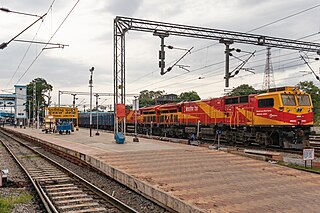
Guntakal Junction railway station is located in Anantapur district in the Indian state of Andhra Pradesh and serves Guntakal. It is also the headquarters of Guntakal railway division in South Central Railway. It is a junction station at the intersection point of the Mumbai–Chennai line, the Vijayawada–Marmagova line and the Guntakal–Bengaluru line.

The Chennai Central – Bangalore City line is an electrified railway double line which connects the cities of Chennai and Bengaluru in South India.
The Chord Line connects Viluppuram Junction and Tiruchirappalli Junction, via Virudhachalam Junction in Tamil Nadu. It is the shortest, busiest and most vital route connecting Chennai Egmore and Southern Tamil Nadu.

Braganza Ghats are a stretch of hill section in the Western Ghats alias Sahyadri Range at the Karnataka – Goa border. This 26 km ghat section rail road connects coastal Goa to the hinterlands of Karnataka and other parts. It has three stations en route in the ghats – Caranzol, Doodhsagar and Sonaulim.
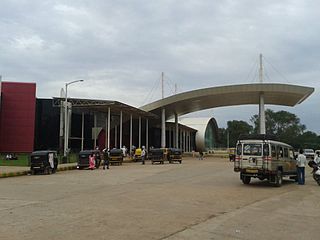
Shree Siddharoodha Swamiji Hubballi Junction Railway Station, is a railway junction station under Hubballi railway division of South Western Railway zone (SWR) of Indian Railways situated in Hubli, Karnataka, India. The platform number 1 of Hubli Junction has a length of 1,507 metres, making it the longest railway platform in the world as of March 2023.

The YDM-4 is a class of diesel locomotives operating on Indian Railways. The first units were built by the American Locomotive Company (Alco) in 1961. Since 1968, members of the class have been manufactured in India by the Banaras Locomotive Works (BLW), Varanasi. The model name stands for metre gauge (Y), diesel (D), mixed traffic (M) engine. The YDM-4 has been the most successful metre gauge diesel locomotive in India. The YDM-4 locos have a maximum speed of 100 km/h (62 mph), restricted to 85 km/h (53 mph).

Diesel Loco Shed, Gooty is an engine shed located in Gooty, Andhra Pradesh in India. It falls under the jurisdiction of Guntakal railway division of South Central Railway zone.

The Indian locomotive class WDM-3D is a class of diesel–electric locomotive that was developed in 2003 by Banaras Locomotive Works (BLW), Varanasi for Indian Railways. The model name stands for broad gauge (W), Diesel (D), Mixed traffic (M) engine with 3300 horsepower (3D). The engine is classified WDM-3D though it outputs only 3300 hp and not 3400 hp as the name should suggest. They entered service in 2003. A total of 590+ WDM-3D were built at Banaras Locomotive Works (BLW), Varanasi between 2003 and 2016.
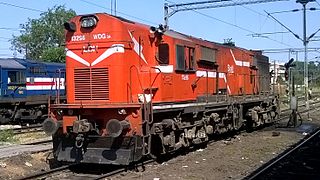
The Indian locomotive class WDG-3A is a class of diesel–electric locomotive that was developed in 1994 by Banaras Locomotive Works (BLW),Varanasi for Indian Railways. The model name stands for broad-gauge (W), Diesel (D), Goods traffic (G) engine, 3,100 hp (3A) locomotive. They entered service on 18 July 1995. A total of 1,164 WDG-3A units were built between 1994 and 2015 at BLW, Varanasi with a few units being produced by Diesel Loco Modernisation Works (DLMW) and Parel Workshop.

The Indian locomotive class YDM-5 is a class of diesel–electric locomotive that was developed in 1964 by General Motors (GM-EMD) for Indian Railways. The model name stands for Metre gauge (Y), Diesel (D), Mixed traffic (M) engine, 5th generation (5). They entered service in 1964. A total of 25 YDM-5 locomotives was built between 1963 and 1964.
The Indian locomotive class YDM-3 is a class of diesel–electric locomotive that was developed in 1964 by GM-EMD for Indian Railways. The model name stands for Metre gauge (Y), Diesel (D), Mixed traffic (M) engine, 3rd generation (3). They entered service in 1962. A total of 30 YDM-3 locomotives was built between 1961 and 1962.
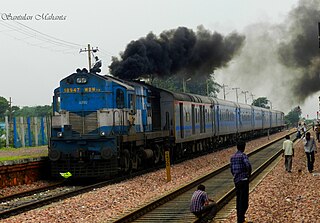
Diesel Loco Shed, Abu Road is a motive power depot performing locomotive maintenance and repair facility for diesel locomotives of the Indian Railways, located at Abu Road railway station (ABR) in Abu Road city in the Indian state of Rajasthan. It is one of the two diesel loco sheds of the North Western Railway, the others being at Bhagat ki Kothi.

Diesel Loco Shed, Tondiarpet is a motive power depot performing locomotive maintenance and repair facility for diesel locomotives of the Indian Railways. It is located near Tondiarpet railway station (TNP) of the Southern Railway zone in the city of Chennai, Tamil Nadu and is one of the four diesel loco sheds of the Southern Railway, the others being at Ernakulam (ERS) at Kochi, Erode (ED) and Golden Rock (GOC) at Trichy.

The Diesel & Electric Loco Shed, Krishnarajapuram is a motive power depot performing locomotive maintenance and repair facility for diesel locomotives and electric locomotives of the Indian Railways, located at Krishnarajapuram (KJM) of the South Western Railway zone in the city of Bangalore, Karnataka. It is one of two diesel loco sheds and only electric loco sheds of the South Western Railway, the other being at Hubli.





















